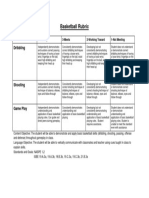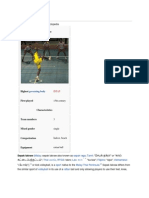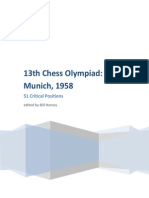Chess Rules and Regulation
Uploaded by
ralphChess Rules and Regulation
Uploaded by
ralphRules and Regulations of Chess
These are the Basic Rules and Regulations of the game of Chess.
If you want to learn to play the chess a basic understanding of the
Regulations is crucial
The rules are not always going to help you win a game. The Great skill of the game is understanding how your
opponent will use the regulations of chess to work out many, many different potential chess moves.
Early chess rules book
The rules of Chess in full are fairly comprehensive but detailed below is a condensed version of the Chess
Objective of the game of Chess.
Chess is a two-player game played on a board consisting of 64 (8x8) squares arranged in alternating light and dark
colors and 32 Chess men (16 of either black or white for each player). There are six different types of Chessmen,
each of which can move in their own unique way. The objective of the game is to protect your most valuable piece,
the king, and trap (checkmate) your opponents king.
The Game of Chess Starting positions
The Chess board is positioned so that a light colored Chess Board square is in the near-right corner to each players
position. Each Chess player takes control of sixteen Chess pieces or Chessmen, in either black or white, consisting
of the following:
1 king Chess Piece
1 Queen Chess Piece
2 Rook Chess Pieces
2 Bishop Chess Pieces
2 Knight Chess Pieces
8 Pawn Chess Playing Pieces
The above Chess pieces are arranged on the Chess board. The row of chess pieces nearest to the player contains
the rooks on the outside corners and moving inwards, the knights and bishops with the king and queen occupying the
centre two squares (the queen is always placed on the corresponding square color white on light, black on dark)
This layout is also described as Queen to colour.
Beginning a game of Chess
The Chess Players choose a colour each either by mutual agreement or by flipping a coin. Another traditional way of
determining a Chess players colour is through one player concealing a pawn chess piece of each color in each hand
and asking their opponent to select a hand (and therefore a colour to play the game of chess with).
The Chess player controlling the white coloured Chessmen moves first and each player then takes it in turns to make
a move until either a draw is called by the Chess players or until either players King Chess piece is trapped by
means of checkmate.
Moving the Chess Pieces or Chessmen.
Each of the eight types of Chessmen move in their own different and unique ways. Although a piece cannot pass
through a square containing other pieces it can move in to a square occupied by an opposing piece, which is then
taken or captured and removed from the board. Each of the Chessmen can move in the following ways:
The Rook Piece
Moves orthogonally to the players (forward, backward, left or right) across any number of unoccupied squares.
The Bishop Piece
The Bishop Chess piece moves diagonally across any number of unoccupied chess squares.
The Queen Piece
The Queen Chess Piece moves orthogonally or diagonally across any number of unoccupied squares.
The King Piece
The King Chess Piece moves orthogonally or diagonally one square at a time.
The Knight Piece
The Knight Chess Piece moves in an L shape. Either two spaces in one direction then one space at right angles
(orthogonally) to it or one space in one direction then two spaces orthogonally to it. The knight is the only piece that
can jump over other pieces.
The Pawn Piece
The Pawn Chess Piece moves one space forward (away from the controlling player). On its first move, however, a
pawn may move two spaces forward if desired. A pawn can only capture pieces that are situated one space
diagonally in front of it.
In addition to the above moves the king and rook can combine to do a special move called castling. If the king and
rook are still at their starting positions and all of the spaces between them are empty then the king can move two
squares towards the rook and the rook can move to the space that the king has just moved over (all as one move).
Castling, however, is not permitted if the king is threatened or moving to a threatened square and it is always a good
idea to announce your intention to castle to your opponent before carrying out the move.
If a pawn reaches the opponents back line it can become a queen (if the players queen has been captured) in a move
called queening or promotion. Or, alternatively the player can choose for the pawn to become a captured rook or a
bishop (this is called under promotion).
A king cannot be moved at any time in to a position that places or leaves it in check.
In serious play, if a player touches any of his pieces then he/she must move it if it is legally possible to do so. If a
player touches an opponents piece then he/she must capture it if it is legally possible to do so. If a player wishes to
touch a piece to adjust its position on a square then he/she must inform his/her opponent prior to doing so.
If an illegal move is made at any time then the player must retract that move and make another one if possible with
the same piece.
Winning a game of Chess
When a Chess player makes a move that threatens the opposing players king with capture the king is in check. The
opposing player must then make a move whereby the king is no longer under threat either by moving another piece
between the king and the threatening piece, by moving the king, or by capturing the threatening piece. A player may
never leave his/her king in check at the end of a move. When playing informally it is often customary to announce
check when it occurs but this is never done in professional/formal tournament play.
If a king is placed in check and there is no legal move that the player can do to remove the king from the threat of
capture then the king is said to be checkmated and the game is over with the player controlling the checkmated king
losing. Either player may at any time forfeit the game if he/she feels that his/her position is hopeless.
Drawing a Game of Chess - Game Draws
A game may end in a draw if the player to move cannot make any legal move and is not in check (known as
stalemate), if there is no possibility for either player to put his/her opponent in check, or both players agree to draw
by mutual agreement.
Timing Rules. The Rules on timing in a game.
Tournament games are often played under time constraints using a Chess clock. Under these conditions each player
must make his/her move within a specified time, or face forfeit.
In formal competition, each player is also obliged to record each move as it is played in order to settle disputes about
illegal positions and overstepping time control. Algebraic Chess notation is presently used for this, though some
players still use descriptive Chess notation.
You might also like
- Scrabble Rules - Scrabble Official RulesNo ratings yetScrabble Rules - Scrabble Official Rules6 pages
- Facilities and Equipment of Arnis, Participants, Duties and ResponsibilitiesNo ratings yetFacilities and Equipment of Arnis, Participants, Duties and Responsibilities19 pages
- 1.history 2. Facilities & Equipment 3.basic Skills 4.rules and RegulationNo ratings yet1.history 2. Facilities & Equipment 3.basic Skills 4.rules and Regulation31 pages
- Skills in Badminton: Module in Physical Education (P.E 7) 2 Quarter - Week 7No ratings yetSkills in Badminton: Module in Physical Education (P.E 7) 2 Quarter - Week 78 pages
- Grade 8 - Lesson 3.1 History of Volleyball100% (1)Grade 8 - Lesson 3.1 History of Volleyball43 pages
- Drawing and Types of Strokes & Serve in Badminton (Sherren Marie Nala)No ratings yetDrawing and Types of Strokes & Serve in Badminton (Sherren Marie Nala)3 pages
- Chess Training Schedule: Day 1 Day 2 Day 3 Day 4 Instructions100% (4)Chess Training Schedule: Day 1 Day 2 Day 3 Day 4 Instructions1 page
- Badminton Rules, Regulations and Terminologies100% (1)Badminton Rules, Regulations and Terminologies24 pages
- Lesson 2: Facilities and Equipment: RacketNo ratings yetLesson 2: Facilities and Equipment: Racket3 pages
- A 2-Player Game by Luis Bolaños Mures Veletas, A Close Relative To Amazons, Is A Drawless Smaller VersionsNo ratings yetA 2-Player Game by Luis Bolaños Mures Veletas, A Close Relative To Amazons, Is A Drawless Smaller Versions1 page
- CHESS Grandmaster - Kasparovs Chess Openings - by Borik Otto - PDF RoomNo ratings yetCHESS Grandmaster - Kasparovs Chess Openings - by Borik Otto - PDF Room130 pages
- C-fakepathMultukul - Muhazire Unibook PDFNo ratings yetC-fakepathMultukul - Muhazire Unibook PDF344 pages
- E. Schiller & B. Colias - How To Play Black Against The Staunton Gambit100% (2)E. Schiller & B. Colias - How To Play Black Against The Staunton Gambit146 pages
- Power Schematic Diagram (For 47PFL) BoardNo ratings yetPower Schematic Diagram (For 47PFL) Board1 page
- Guitar Chord Chart: The .'S and ,'s After The Chord Name Means That The Chord Is A Duplicate or Alternate FormationNo ratings yetGuitar Chord Chart: The .'S and ,'s After The Chord Name Means That The Chord Is A Duplicate or Alternate Formation3 pages
- Coakley Jeff - Chess Cafe - The Puzzling Side of Chess - 1-93, 912p100% (2)Coakley Jeff - Chess Cafe - The Puzzling Side of Chess - 1-93, 912p912 pages
- A Practical Black Repertoire With d5 c6 Vol 2 The Caro-Kann and Others Defences - Alexei Kornev PDF100% (7)A Practical Black Repertoire With d5 c6 Vol 2 The Caro-Kann and Others Defences - Alexei Kornev PDF534 pages
- Checking DSP On GMP4 and DSP IP AddressesNo ratings yetChecking DSP On GMP4 and DSP IP Addresses36 pages
- 13th Chess Olympiad: Munich, 1958 - 51 Critical Positions100% (2)13th Chess Olympiad: Munich, 1958 - 51 Critical Positions20 pages

























































































